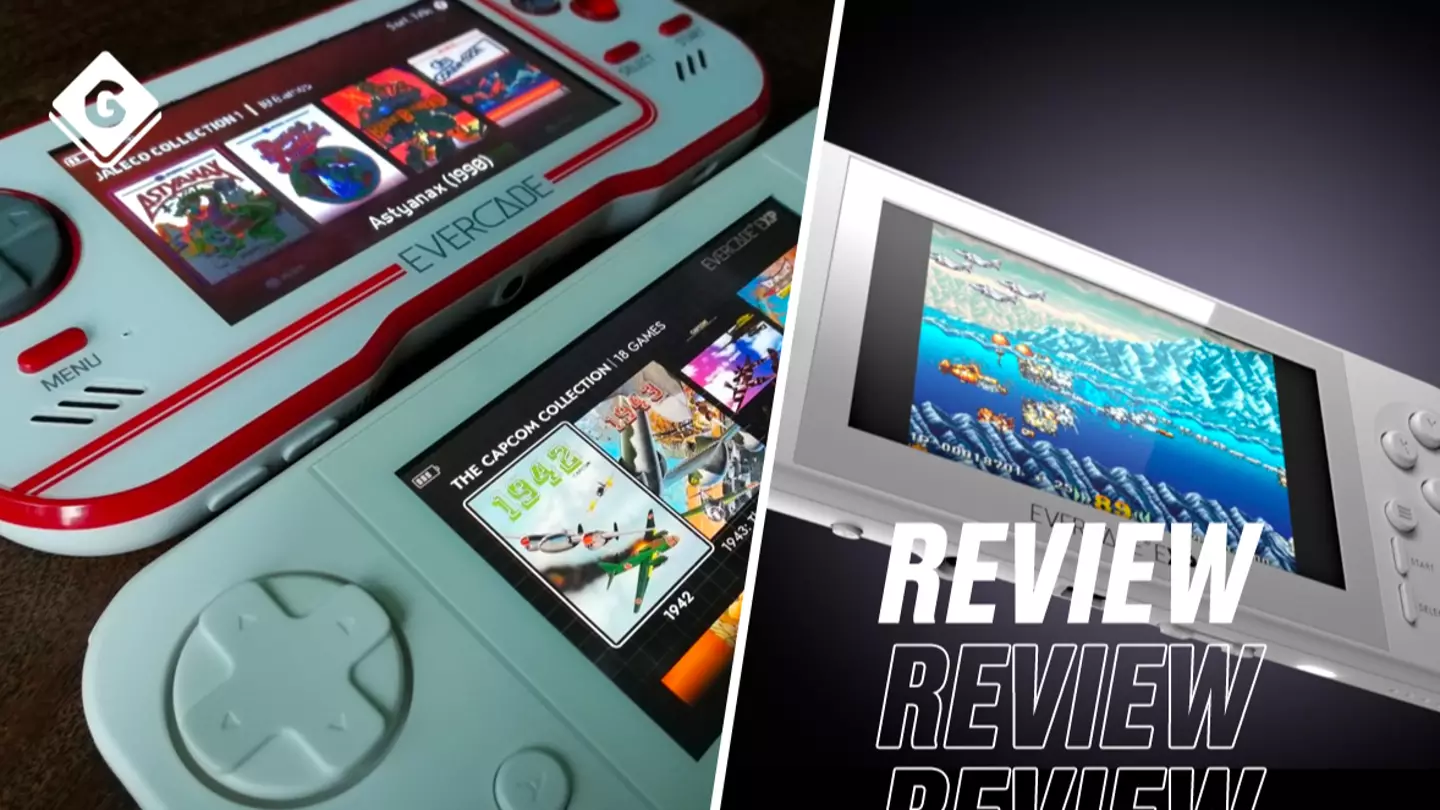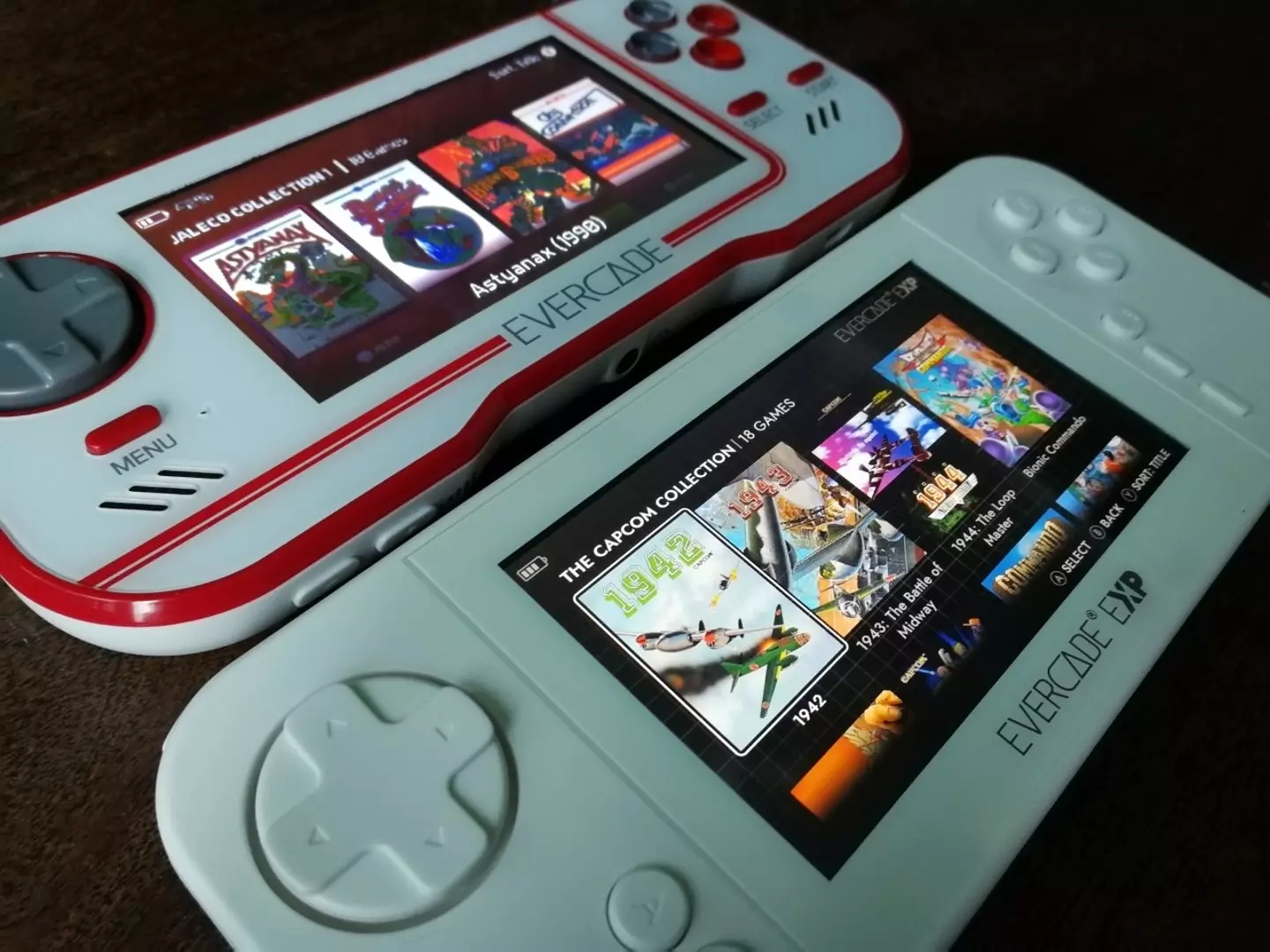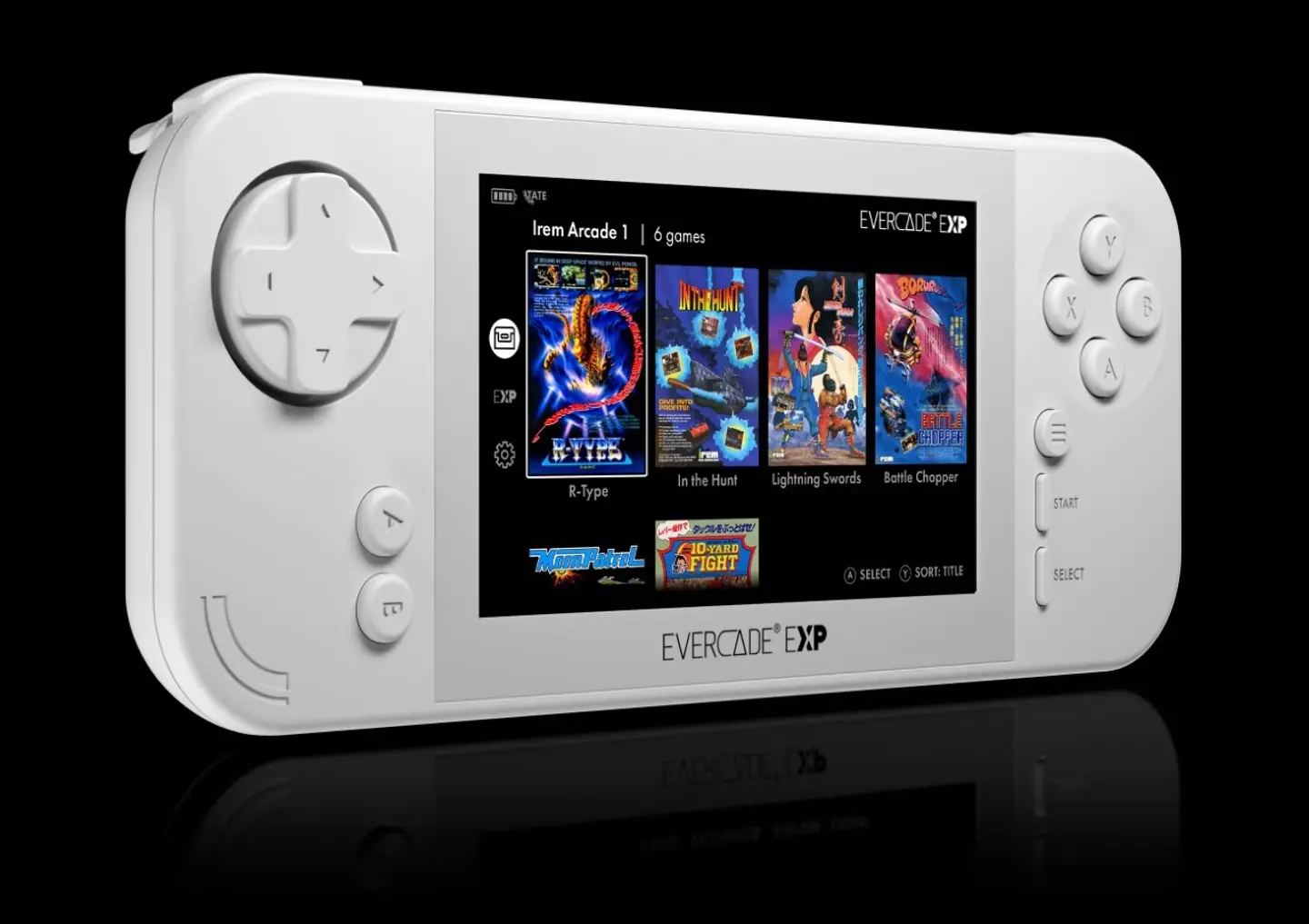
The Evercade EXP improves upon this brand’s original handheld console of 2020 in just about every way. With an improved CPU and additional RAM, increased screen resolution, internal storage of 4GB, 90-degree-rotational TATE functionality, WiFi capabilities and 18 built-in games from Capcom, covering console titles and arcade inclusions, this is a properly premium piece of kit which makes the model of two years ago feel peculiarly toy-like. There’s nothing wrong with the OG Evercade at all – as I wrote at the time, it’s a neat way to play old games in the here and now, and remains as such. But the immediately positive impression the EXP leaves is so powerful that anyone owning the previous system will struggle to go back to it. If you only keep one in your backpack, this is it.
Evercade has always been about bringing the past into the present, whether for on-the-go sessions or at-home, multiplayer-ready fun with the quad-controller-ported VS console (it takes its Nintendo cues, and we’re here for it). Its library of multi-game cartridges appeal to collector sensibilities, all entries numbered for the catch ‘em all satisfaction of a full shelf; and with compilations from the likes of Atari, Namco, The Bitmap Brothers, Codemasters and Data East already available, there’s a lot of bang in this ecosystem for very little buck as carts never cost over £20. Assuming, that is, you’re of the retro-leaning persuasion, or you’ve an interest in digging into video gaming’s evolution. Evercade carts typically range from 8- to 32-bit experiences, with arcade releases coming through since the VS’s launch and a special line for home computers launched with the first C64 Collection (Amiga games are on the way, too). There’s also room in the software selection for modern-made, retro-styled delights, such as the exceptional metroidvania Cathedral and twin-stick shooter Xeno Crisis.

If all of that piques your interest but Evercade’s not been on your radar until now, the EXP’s arrival is perfectly timed, as it really is the first piece of hardware from manufacturers Blaze Entertainment that you can put into someone else’s hands and they’ll want one for themselves, such is the instant-click appeal of this marvellously designed device. Whereas the VS’s controllers were lightweight compared to other machines’ inputs, and the first Evercade handheld has a certain clickety clackety feel that could be perceived as cheapness (kept the RRP down, though), the EXP is like going from a supermarket smartphone picked up from the specials aisle to the latest handset from Apple: a world apart from the first interactions. It has weight, enough to sit solid in the palms but not prove an ache on the digits after longer spells; its small, slightly recessed face buttons – A, B, X and Y – have a finely balanced spring and bite to them, and the four shoulder buttons snap sharply (no analogue triggers here); and while the screen-surrounding bezel could perhaps be slimmer it doesn’t feel intrusive on the screen real estate whatsoever.
Advert
The EXP’s D-pad uses the SEGA-style single disc approach rather than Nintendo’s plus-sign design, making the quarter-turn sweeps for fighting titles easy to execute; and when the unit is switched to TATE mode using a circular ‘T’ button on its underside – thus making vertical shooters play as intended, in a portrait format – the D-pad automatically reassigns its left and right and up and down, no further fiddles required. Games from across the Evercade library that are TATE supported are indicated as such on the selection screen, and should you prefer to play them squashed on a landscape layout, you still can. You pay your money, you take your choice. Playing in TATE mode is initially a little unusual, as the EXP feels a little long and unbalanced due to its ‘regular’ face buttons, select and start and the menu button being right up there, above the screen; but a few minutes into Mercs and 1943: The Battle of Midway and it grows in comfort, whether index fingers are tucked behind or straight up the sides of the unit (larger-handed players will have to adopt the latter position).
The one question mark over the EXP’s TATE design is its paperwork’s warning to not cover certain vents on the rear of the device. This area is easily avoidable when the handheld’s in its regular horizontal set-up, but flipped to stand tall the airflow can be partially restricted by the player’s fingers. You can kind of crunch your knuckles up and only grip the very end of the unit, but it’s preferable and more natural to let your fingers sit across the back of where the screen is, across the cartridge slot (if one’s inserted) and those all-important vents. In a few hours of constant testing, flicking back and forth from EXP mode, I didn’t note the EXP getting exceptionally warm, but it’s something to bear in mind. Otherwise, the TATE A and B buttons feel as good as their horizontal counterparts, and it’s not too much of a faff to stretch a finger up to access select (usually used as the insert-coin command for coin-ops), start and the menu button.

Elsewhere on the EXP you’ll find an all-important USB-C port for charging the console (a USB-A to USB-C cable is included, and the battery life is between four and five hours), a 3.5mm headphone socket, volume up and down buttons, a mini HDMI out for plugging this into your telly for big-screen 720p play (it works fine, but there’s no lead included in the box), and a power button that is pressed for two seconds to turn the unit on or off. The power-on light is on the underside of the unit, and will flash an angry red when the system needs charging. As well as a simple quick-start guide, inside the EXP’s colourful box is a full manual for the 18 pre-installed Capcom games, featuring special-move commands for the arcade version of Street Fighter II: Hyper Fighting, an icon guide for the SNES RPG Breath of Fire, and a little history on the Japanese developer. It’s one of those things other manufacturers often skimp on, but Evercade makes a point of including chock-full booklets with its releases, and it’s a treat that Capcom Collection gets one too.
Advert
The other 16 games here, pre-loaded and ready to play straight away, are (deep breath): Mega Man and Mega Man 2 (NES ports), Mega Man X (SNES), Strider (arcade, as are all following titles), Commando, Mercs, 1942, 1943: The Battle of Midway, 1944: The Loop Master (a big personal favourite of mine, developed not by Capcom but by 8ing), Bionic Commando, Captain Commando (no relation), Final Fight, Legendary Wings, Vulgus (Capcom’s first game, ever), Forgotten Worlds, and the evergreen nightmare of quarters-munching difficulty spikes that is Ghouls ‘N Ghosts. It’s a fine spread indeed – not a complete document of Capcom’s most-loved and critically feted productions, but a beautiful selection of important arcade and console releases nonetheless. They all play well, look excellent on the EXP’s 800x480 display, and are supported by six save slots per game, a feature that carries over to every Evercade title. So too do options covering scan lines (strong, subtle or off), border designs (pretty pictures, artwork, nowt whatsoever etc), and the choice between original display ratio, a pixel-perfect setting or a stretched full-screen approach that makes most of these older, meant-to-be-4:3 games look a little unwell. But again: your money, your choice.
While there’s sure to be disappointment amongst those already well invested in the Evercade ecosystem that these Capcom games are digital only and not available on a cartridge, for them to be here at all is a huge win for the brand and – hopefully – a sign of other big-name associations to come. Is it asking too much to see releases in the future from Konami, Electronic Arts, LucasArts, Midway or even SEGA? I don’t think any of those are beyond the realms of possibility anymore – even if they (ultimately have to) arrive as downloads and not on small plastic rectangles that fit the curvature of the EXP’s shell. But the core physical appeal of these collectable compilations is expressed with the inclusion of the Irem Arcade 1 cart in the standard EXP package, store snugly in the box. This six-game set features the iconic side-on shooter R-Type, the rarely seen hack-and-slasher Lightning Swords, subaquatic shoot ‘em up In The Hunt, and the American Football game 10-Yard Fight. Also released around the same time as the EXP but not included as standard is Toaplan Arcade 1, with the TATE-ready Truxton and Flying Shark, and six further coin-op ports.

I’ve not tested the entire Evercade library on the EXP, but what I have played has consistently proven to be better on this machine than the previous handheld. Once you’ve had just a single Sensible Soccer or Speedball 2 match on the EXP, going back to the OG system reveals a difference far more pronounced than, for example, the OG Switch to OLED step up. It’s night and day, put side by side. The console’s UI includes a tracker, recording how many times you’ve played a game and overall time spent on it, which is neat; and there’s also an option to restrict your coins for arcade ports, should you want that real-life experience of starting a playthrough of Final Fight with just enough pocket change for three continues. VS owners will note the inclusion on the EXP menu – where you’ll also find the Capcom games – of a Hidden Games section. On start-up this is empty, but those who know a code or two that worked on the home console are encouraged to try the same here. You never know what may pop up.
Advert
At £129.99 for the basic package – Capcom and Irem collections included – the EXP is well priced to compete with emulation handhelds from the likes of Anbernic and GoRetroid. Unlike those systems, everything playable on the Evercade family of consoles is fully licensed, and there’s no need to tinker with emulation settings to get the games just right. Naturally your selection is limited to the cartridges available, but with 27 home console collections available right now, eight arcade compilations and a Commodore line just kicking off, there’s plenty to pick from and favourites old and new to find. Its build quality is also on a par with the best of those devices, almost at a Nintendo level of tough and tactile goodness. If older games absolutely aren’t your thing, it goes without saying that what Evercade is offering isn’t for you. But for anyone who played through the 1980s, ‘90s and ‘00s, who loved pumping coins into cabs to play blasters and brawlers that home systems of the time simply couldn’t replicate, or who wants an affordable way to explore this medium’s progression from primitive 2D planes to fully immersive playgrounds, Evercade’s MO should strongly appeal. Its proven itself to be a valuable side attraction to a gaming mainstream dominated by the big three, and the EXP is the best hopping-on point any newcomer to this range could hope for.
The Evercade EXP console is released on December 15, 2022. Review unit supplied by Blaze Entertainment.
Featured Image Credit: EvercadeTopics: Retro Gaming
